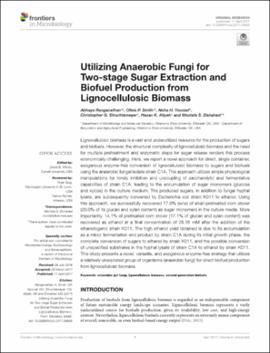| dc.contributor.author | Ranganathan, Abhaya | |
| dc.contributor.author | Smith, Olivia P. | |
| dc.contributor.author | Youssef, Noha H. | |
| dc.contributor.author | Struchtemeyer, Christopher G. | |
| dc.contributor.author | Atiyeh, Hasan K. | |
| dc.contributor.author | Elshahed, Mostafa S. | |
| dc.date.accessioned | 2019-08-28T16:00:50Z | |
| dc.date.available | 2019-08-28T16:00:50Z | |
| dc.date.issued | 2017-04-11 | |
| dc.identifier | oksd_ranganathan_utilizinganaero_2017 | |
| dc.identifier.citation | Ranganathan, A., Smith, O. P., Youssef, N. H., Struchtemeyer, C. G., Atiyeh, H. K., & Elshahed, M. S. (2017). Utilizing anaerobic fungi for two-stage sugar extraction and biofuel production from lignocellulosic biomass. Frontiers in Microbiology, 8, Article 635. https://doi.org/10.3389/fmicb.2017.00635 | |
| dc.identifier.uri | https://hdl.handle.net/11244/321377 | |
| dc.description.abstract | Lignocellulosic biomass is a vast and underutilized resource for the production of sugars and biofuels. However, the structural complexity of lignocellulosic biomass and the need for multiple pretreatment and enzymatic steps for sugar release renders this process economically challenging. Here, we report a novel approach for direct, single container, exogenous enzyme-free conversion of lignocellulosic biomass to sugars and biofuels using the anaerobic fungal isolate strain C1A. This approach utilizes simple physiological manipulations for timely inhibition and uncoupling of saccharolytic and fermentative capabilities of strain C1A, leading to the accumulation of sugar monomers (glucose and xylose) in the culture medium. The produced sugars, in addition to fungal hyphal lysate, are subsequently converted by Escherichia coli strain K011 to ethanol. Using this approach, we successfully recovered 17.0% (w/w) of alkali-pretreated corn stover (20.0% of its glucan and xylan content) as sugar monomers in the culture media. More importantly, 14.1% of pretreated corn stover (17.1% of glucan and xylan content) was recovered as ethanol at a final concentration of 28.16 mM after the addition of the ethanologenic strain K011. The high ethanol yield obtained is due to its accumulation as a minor fermentation end product by strain C1A during its initial growth phase, the complete conversion of sugars to ethanol by strain K011, and the possible conversion of unspecified substrates in the hyphal lysate of strain C1A to ethanol by strain K011. This study presents a novel, versatile, and exogenous enzyme-free strategy that utilizes a relatively unexplored group of organisms (anaerobic fungi) for direct biofuel production from lignocellulosic biomass. | |
| dc.format | application/pdf | |
| dc.language | en_US | |
| dc.publisher | Frontiers Media | |
| dc.rights | This material has been previously published. In the Oklahoma State University Library's institutional repository this version is made available through the open access principles and the terms of agreement/consent between the author(s) and the publisher. The permission policy on the use, reproduction or distribution of the material falls under fair use for educational, scholarship, and research purposes. Contact Digital Resources and Discovery Services at lib-dls@okstate.edu or 405-744-9161 for further information. | |
| dc.title | Utilizing anaerobic fungi for two-stage sugar extraction and biofuel production from lignocellulosic biomass | |
| osu.filename | oksd_ranganathan_utilizinganaero_2017.pdf | |
| dc.description.peerreview | Peer reviewed | |
| dc.identifier.doi | 10.3389/fmicb.2017.00635 | |
| dc.description.department | Microbiology and Molecular Genetics | |
| dc.description.department | Biosystems and Agricultural Engineering | |
| dc.type.genre | Article | |
| dc.type.material | Text | |
| dc.subject.keywords | anaerobic gut fungi | |
| dc.subject.keywords | second generation biofuels | |
| dc.subject.keywords | lignocellulosic biomass | |
